Distinguished Critique: Batman: Rules of Engagement Review
This narrative uniquely sets the Dark Knight Detective against Lex Luthor, a battle of wits hampered slightly by a Batman too clever for his own good
—by Nathan on October 31, 2023—
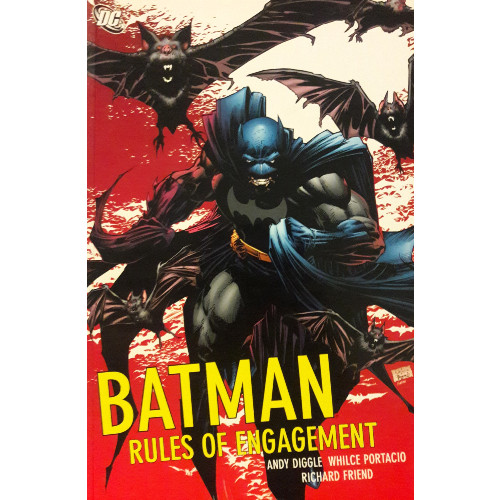
There are rules to everything. How to play a game, drive safely, conduct yourself in a meeting, wage war. These rules, should they be followed, are intended to convey a proper conduct to all parties to ensure safety and success. If you or I each choose to stop at a red light, we hope the others around us will do the same; if someone ignores the light and zooms right by, they risk danger and harm to themselves and others.
Let’s say–completely hypothetically–you’re the CEO of a giant tech company in Gotham City, and let’s also say–completely hypothetically–you’re in a Department of Defense contract bid against LexCorp, the biggest tech company in Metropolis. Well, you would hope both yourself and Lex Luthor, Mr. CEO of LexCorp himself, would play fair and square, right? You’d hope neither of you would unduly influence the proceedings to gain advantage over the other person. That just wouldn’t be fair.
But this is Lex Luthor we’re talking about. Since when does a guy who daily wages war against an invulnerable superhuman consider "fair play" in even his most menial of business transactions? Of course, Mr. CEO of LexCorp is about to learn that anyone playing unfair in Gotham is about to run afoul of Mr. CEO of Waynetech’s alter ego.
Batman’s a little serious about this stuff. You could call him a rule-breaker breaker.
Batman: Rules of Engagement
Writer: Andy Diggle
Penciler: Whilce Portacio
Inker: Richard Friend
Colorists: David Baron, I.L.L.
Letterers: Travis Lanham, Rob Leigh
Issues: Batman Confidential #1-6
Publication Dates: February 2007-June 2007, August 2007

Note: save for some minor edits, this blog is the same as it was when I originally posted it to Hubpages
The premise of Batman Confidential was very similar to its sister series, Superman Confidential, which began a month earlier: tell tales of a certain superhero set early in their careers, with a modern flourish. The series doesn’t necessarily seem to be a retcon of earlier stories, simply a more modern lens flashing against untold tales of the past.
This set-up allows Diggle and Portacio to toy with an engaging source of conflict: Batman’s first clash with Lex Luthor. It’s a unique way to kick off your series–one would surmise that a book set in Batman’s early days would first introduce major rogues (and, in fact, the following arc would do that, offering an updated examination of Batman’s first conflict with the Joker). And yet the Wayne/Luthor angle works well, simply because both men are powerful business owners competing over the same contract.
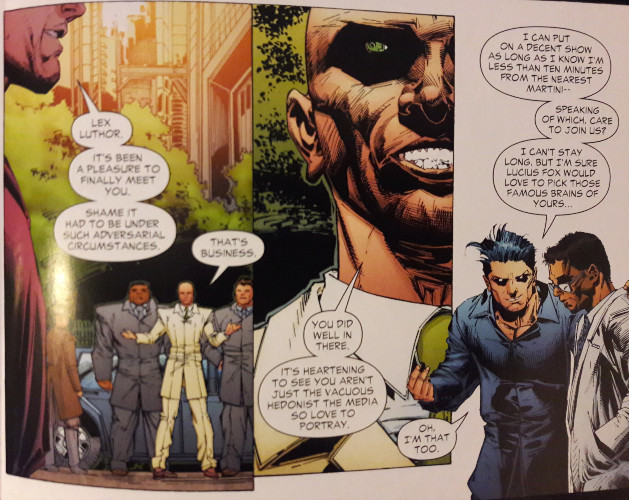
Diggle utilizes the narrative to show the vast moral difference between Wayne and Luthor. No reader checking this out will doubt Luthor’s motivations and manipulations from the very beginning, even if Diggle dangles the idea subtly for a while. As soon as events go awry, including a rogue Waynetech AI system gone haywire, corporate espionage and sabotage become the deal of the day, and anyone with even a shred of understanding as to who Lex Luthor is will start pointing fingers at his shaved head.
But even the implications, which soon become stark reality, indicate how both men operate. Luthor’s "no prisoners" strategy points to a deep ruthlessness and selfishness, a no holds barred system of methodically incriminating threats like Waynetech or even manipulating or blackmailing allies. Luthor and Wayne’s first face-to-face meeting postures Luthor as the consummate businessman, with later scenes revealing his facade. It’s nothing that we haven’t seen before–a temperamental Luthor in Geoff Johns and Gary Frank’s Superman: Secret Origin pitches a trophy through a window in a fit of rage, a stark contrast to his intentionally manicured public persona. This divided, hypocritical Luthor is to be expected.
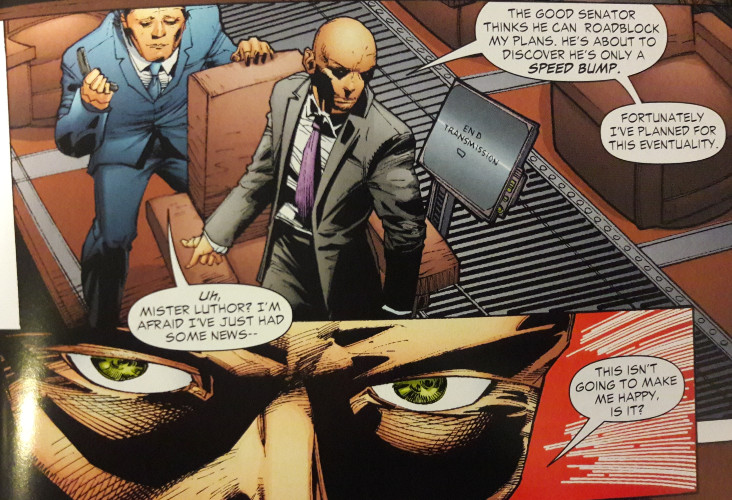
Yet even if he does nothing new with his villain, Diggle at least uses him as a contrast to Bruce Wayne. During a Department of Defense meeting, Wayne proposes that Waynetech’s new AI weapons system could be utilized for more than violence…couldn’t it be used to save lives as well? This mindset catapults Wayne as businessman and Batman throughout the rest of the arc; while Luthor makes underhanded deals and commits espionage to gain the upper hand and the greatest financial gain, Bruce as a businessman always has others in mind. Without the mask, he advocates for a multi-purpose system that can as easily search and save as squash. With the mask, he focuses on rescuing others and putting himself in harm’s way for their safety and in dedication to his parents’ memory. It’s telling that the series ends with Wayne announcing his company will switch from weapons development to more philanthropic aims.
Uniquely, as this tale is set in the past, Diggle allows us a glimpse into the mind of a fairly fresh, inexperienced Batman. There’s a post-"Batman: Year One" feel to the narrative, as if this Batman is slightly deeper into his war on crime yet still finding his footing, similar to how the character behaves in the recent, Robert Pattinson-led movie. In an early scene, he sits in the Batcave, with a stolen gun in hand. He identifies the gun as the weapon used to kill his parents, their murder fresh in his mind. Though countless writers have used the death of the Waynes as Bruce’s primary motivation in his actions, Diggle presents the act with a more emotional bent, with Bruce’s mindset towards the gun veering toward sentimental.
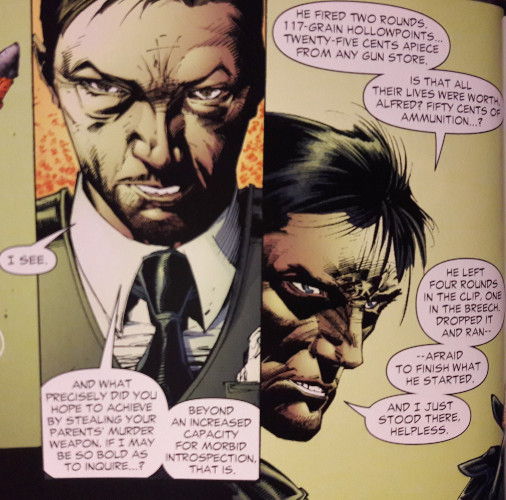
I would have appreciated, at some point, to have seen Diggle’s version of Batman stumble a little. Bruce Wayne learns a very important lesson after his dealings with Luthor, shifting Waynetech away from weaponry and towards philanthropy, but little is done to craft characterization for the Caped Crusader. I was perhaps hoping for a "Year One"-esque Batman, a little overwhelmed and perhaps a tad underprepared. In that arc, Frank Miller creates multiple moments where Bruce is forced to think on his feet, with only his mind and muscle to save him. No technology, no gadgets. In "Rules of Engagement," Batman provides himself the necessary technology in any pinch; sure, one could argue he has the wherewithal to prepare himself properly, but Batman’s preparedness here feels like deus ex machina, where the vigilante suddenly displays a gadget or gizmo to save himself or prevent disaster. As readers, we’re meant to assume he thought of it ahead of time, but based on how these scenes are written, I felt like Diggle wrote Batman into a few corners and used the mythos of Batman’s super-preparedness to create coincidental means for the hero to save himself.
Whilce Portacio is not an artist I am familiar with, unlike Tim Sale, John Bryne, or Gary Frank. For those artists, I appreciate commenting on their art in one story compared to their work in another–how does Tim Sale’s pencils in "Kryptonite" compare to his art in Superman For All Seasons?–which I am unable to do for Portacio here. His pencils remind me of Joe Quesada, the artist behind "Daredevil: Guardian Devil" (a personal favorite Daredevil arc) and "Spider-Man: One More Day" (definitely not a favorite Spidey arc). Like Quesada, Portacio straddles a fine line between the realistic and the fantastic–a few proportions are a tad exaggerated, but on the whole, the artist gives the tale a healthy dose of grounded realism. As a quick side note, I'll comment more on Portacio's work in a future "Random Reviews" post, as he was one of the seven original Image partners whose inaugural series I've reviewing piece-by-piece.
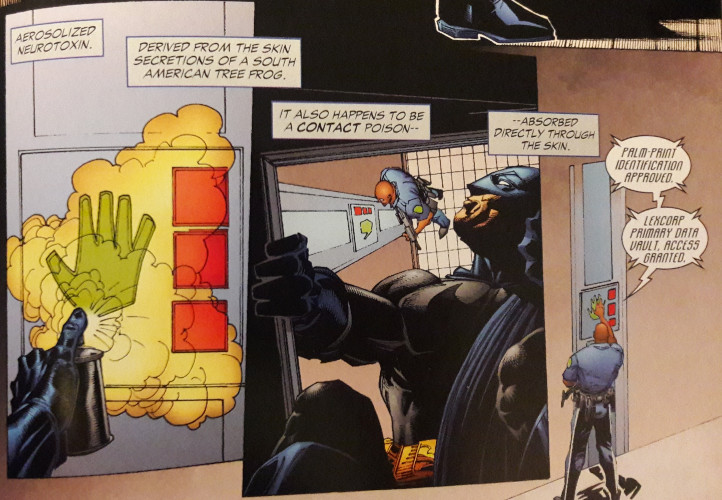
Here, Protacio’s given the chance to invent scads of dangerous robots, but when he isn’t dealing with the technological, he keeps his world fresh and real. His Gotham doesn’t contain the same level of dank grit one would find from Frank Miller’s Dark Knight Returns or "Year One," nor the horror expected from Dave McKean’s quasi-painted Arkham Asylum: A Serious House on Serious Earth. Sure, Batman winds a path through an abandoned facility and spends time brooding in his mansion’s bat-infested sub-basement, but several scenes allow Gotham to feel like a city with weighty prominence, more akin to Metropolis instead of the crime capital of the world.
If you’re looking for a somewhat simpler, easier narrative to swallow, this "Rules of Engagement" arc should go down nicely enough. It’s not too deep or stuffed to the brim with references and history for continuity buffs. It will never be as iconic as Year One in terms of "modern stories set early in Batman’s career," but as an exploration of a young Batman squaring off against Superman’s most hated foe, the narrative gets some points for creativity. If anything, the story nails the Luthor portrayal and Bruce Wayne’s philanthropic attitude, allowing these touchpoints to work off and influence each other, creating a cohesive story where the pieces flow uniquely throughout the larger plot.
Postscript: Happy Halloween, all! It felt appropriate to post a Batman review today. With some forethought, I could have wrangled up a review for one of Jeph Loeb and Tim Sale's spookier Batman contributions, but I considered it way too late. Maybe next year. For now, I've reached the end of my previously published Distinguished Critique posts, from when I was reviewing DC Comics narratives at Hubpages. Now, we can move forward with new reviews I've written while posting these blogs to Keenlinks. With the last few posts, I've strayed a little from the "immediate aftermath of the post-Crisis on Infinite Earths" pattern I was establishing, but not to worry. As I noted in my introductory post, I'm allowing myself to be more flexible with this series, not taking any "diversions" too seriously. I want to get back on the track I established, however, so next post, it's back to the 80s, as I continue unpacking that particular era of the rapidly-changing DC Comics universe.